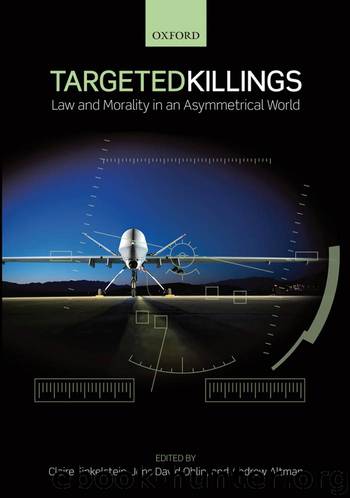Targeted Killings by Finkelstein Claire Altman Andrew Ohlin Jens David & Jens David Ohlin & Andrew Altman

Author:Finkelstein, Claire, Altman, Andrew, Ohlin, Jens David & Jens David Ohlin & Andrew Altman
Language: eng
Format: epub
Publisher: OUP Oxford
Published: 2012-06-25T16:00:00+00:00
Source: O’Connell, Mary Ellen, “Unlawful Killing with Combat Drones: A Case Study of Pakistan, 2004–2009. Shooting to Kill: The Law Governing Lethal Force in Context,” Simon Bonitt (ed.), Notre Dame Legal Studies Paper No. 09–43 forthcoming. Available at: <http://ssrn.com/atract/501144>.
The core requirement to minimize collateral damage is one of the fundamental motivations for criteria-based decision-making in targeted killing. In the absence of criteria for decision-making, at best targeted killing will pay mere lip service to this key international law requirement. In that vein, the recent CIA claim that not one noncombatant has been killed in drone attacks in 2011 is,10 at the least, an eyebrow raiser.11
The world of operational counterterrorism decision-making is extraordinarily complex; it is also high-risk and fraught with danger. The burdens imposed on the decision-maker are extraordinary because of the overwhelming responsibility to ensure the safety of soldiers under his command and also to protect innocent civilians. Although the rules of engagement that codify when an “open fire” order may be given are carefully written and subject to thorough examination by a wide range of experienced professionals, the ultimate decision is made in the field by a commander exercising discretion subject to an infinite set of circumstances.
Precisely because those circumstances impact the commander’s judgment, the criteria-based model is an essential mechanism for increasing the effectiveness of the targeted killing policy. To that end, I define effectiveness as the correct identification and targeting of a legitimate target (based on imminent threat and necessity) subject to stringent collateral damage restrictions. Implementing this policy in accordance with this two-part test demands a criteria-based approach.
This chapter is based on my twin perspectives of having served as a legal advisor in the IDF and now as a professor of law with numerous opportunities to reflect on decisions in which I was involved.12 My concentration on “process” stems from my belief that a criteria-based model of decision-making is essential to minimizing collateral damage and enhancing the effectiveness of existing policies. Simply put, beyond the legal, moral and theoretical underpinnings, lawful targeted killing must be based on criteria-based decision-making, which increases the probability of correctly identifying and attacking the legitimate target. A state’s decision to kill a human being during a counterterrorism operation must be predicated on an objective determination that the “target” is, indeed, a legitimate target. Otherwise, the state’s action is illegal, immoral and ultimately ineffective. Subjective decisions based on fear or perception alone pose grave danger to both the suspected terrorist and innocent civilians.
It goes without saying that many object to the killing of a human being when less lethal alternatives are available to neutralize the “target.” Others will suggest—not incorrectly—that targeted killing is nothing but a manifestation of the state acting as “judge, jury and executioner.” On the other hand, the state has a responsibility to develop and implement measures protecting innocent civilians from enemies who kill and maim innocent civilians. The need for an objective determination that the person in the crosshairs is a legitimate target requires a method to enhance the decision-making process in the face of extreme pressure.
Download
This site does not store any files on its server. We only index and link to content provided by other sites. Please contact the content providers to delete copyright contents if any and email us, we'll remove relevant links or contents immediately.
The Pirates of Somalia by Jay Bahadur(1587)
Political Theology by Carl Schmitt(1545)
The Holocaust: A New History by Laurence Rees(1488)
The Social Animal by David Brooks(1411)
A Practical Guide to International Arbitration in London by Hilary Heilbron(1396)
Restitution by Restitution(1394)
Pirates of Somalia by Jay Bahadur(1348)
Coercing Virtue by Robert H. Bork(1325)
The Nuremberg Interviews by Leon Goldensohn(1274)
Basic International Corporate Taxation by Sebastiano Garufi(1179)
A History Of Thailand by Baker Chris(1153)
International Trade and Business: Law, Policy and Ethics by Gabriël Moens & Peter Gillies(1109)
The Global Commons by Susan J. Buck(1108)
Asian Waters by Humphrey Hawksley(1094)
Blood Profits by Vanessa Neumann(1090)
The Sovereignty of Human Rights by Macklem Patrick(1076)
Spring Fever: The Illusion of Islamic Democracy by McCarthy Andrew C(1076)
The Nuremberg Trials: The Nazis and their Crimes Against Humanity by Roland Paul(1022)
Crimes Against Humanity: Historical Evolution and Contemporary Application by M. Cherif Bassiouni(997)
